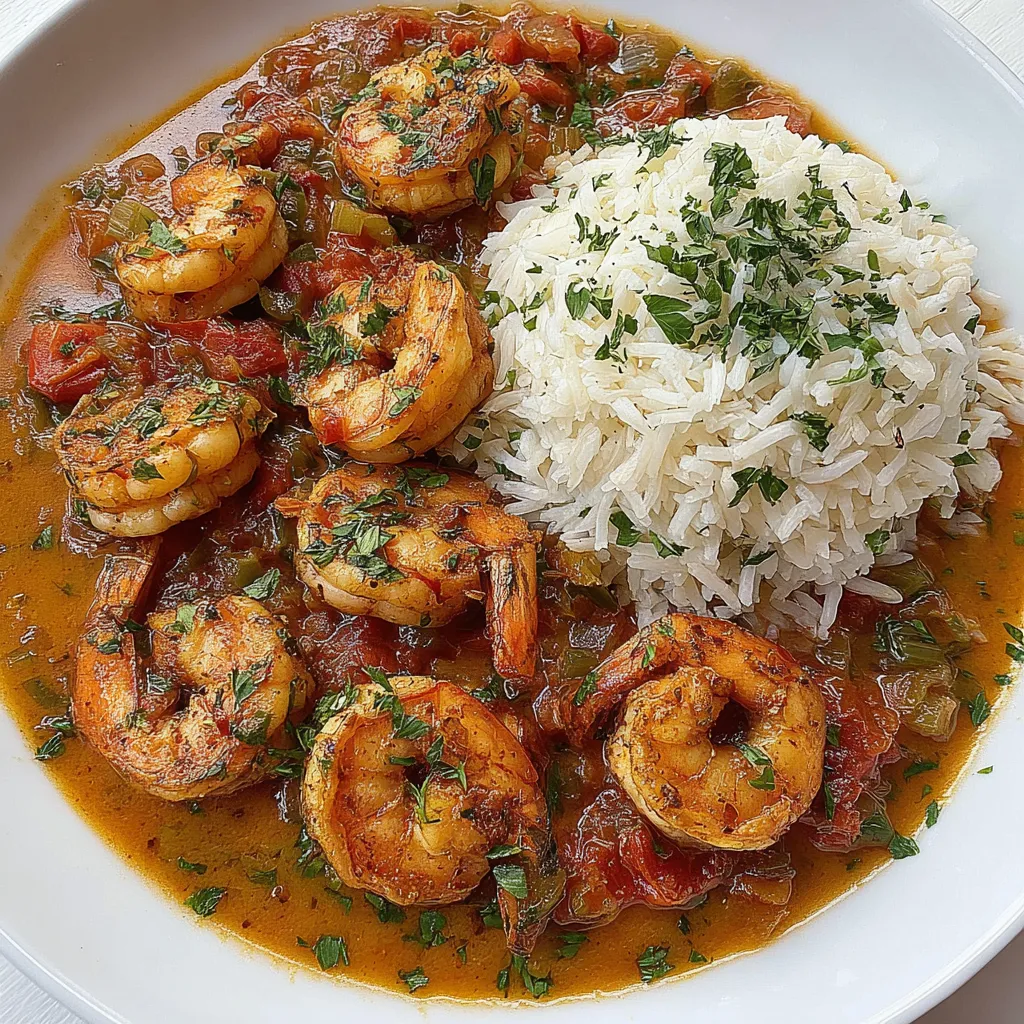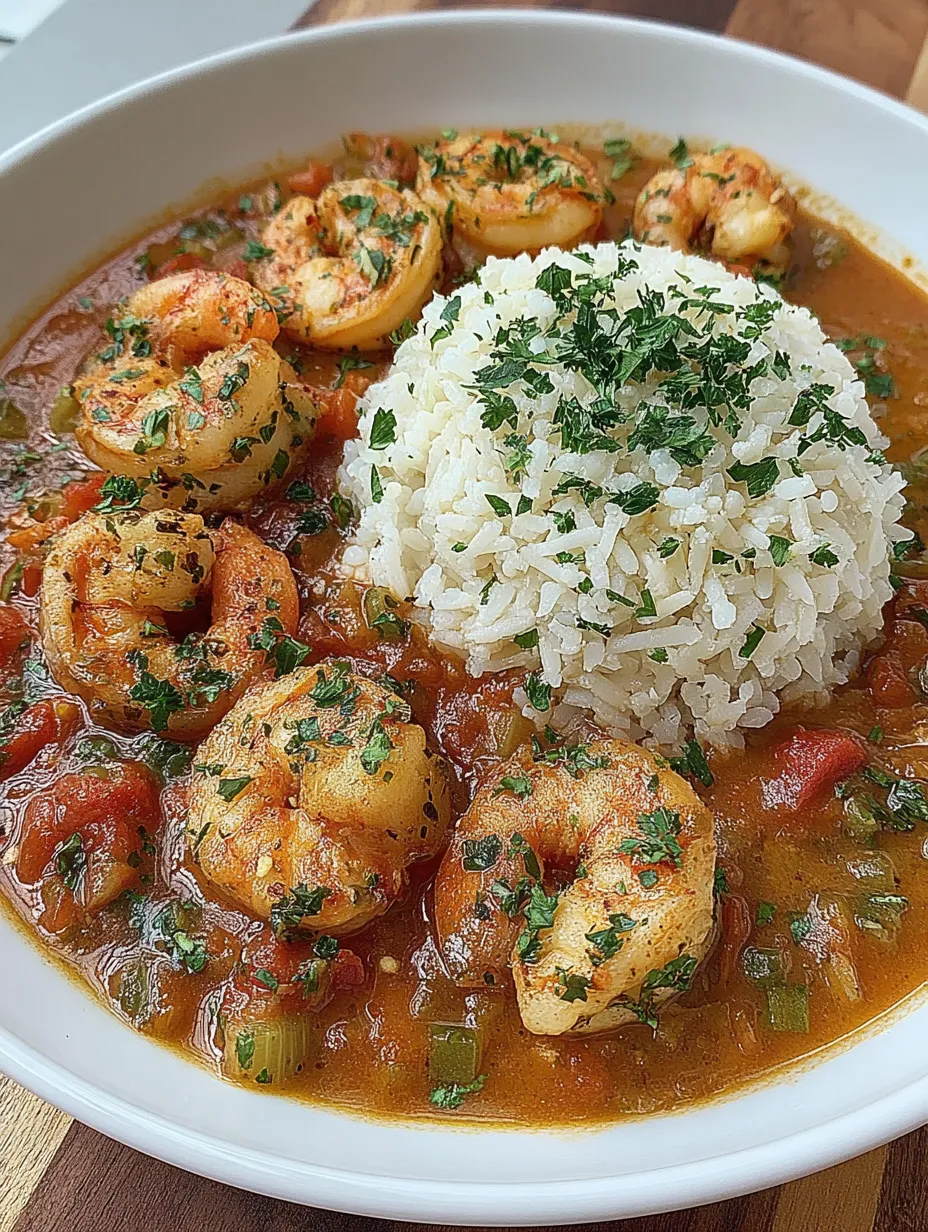 Pin it
Pin it
Shrimp Creole is a celebration of Gulf Coast flavors, featuring tender shrimp nestled in a vibrant tomato and pepper sauce. I come back to this dish whenever I want something both comforting and a little bit lively, especially when I am missing New Orleans.
My family always calls dibs on leftovers before they even finish their first serving. The aroma from the simmering veggies takes me right back to lively family tables and Sunday dinners.
Ingredients
- Large or jumbo shrimp: buy these fresh or frozen and look for shrimp that smell like the sea and are firm to the touch. Peeled and deveined shrimp save a ton of time
- Olive oil or grapeseed oil: for searing the shrimp use a neutral oil with a high smoke point
- Unsalted butter: adds body and depth to the sauce choose a good-quality block for best flavor
- Onion celery bell pepper: these three make up the classic creole holy trinity use vibrant crisp veggies for the freshest taste
- Garlic cloves: freshly minced garlic really brightens the sauce
- Sea salt: bring out all the flavors with a good mineral-rich salt
- Cayenne pepper smoked paprika: the duo that gives warmth and subtle smokiness. Adjust cayenne to your spice preference
- All-purpose flour: for thickening the sauce sift before using to prevent lumps
- Seafood stock or chicken stock: seafood stock creates an authentic flavor base but chicken works in a pinch. Choose low-sodium to control seasoning
- Canned diced tomatoes: use fire-roasted or no-salt-added if possible for the richest tomato undertone
- Worcestershire sauce: for a classic tangy note buy a reputable brand
- Thyme sprigs and bay leaves: add essential herbal backbone always use fresh if possible
- Hot sauce: this one is to taste and to bring just the right amount of kick use your favorite brand
- Fresh parsley: optional but adds bright color and a finish of fresh flavor
Step-by-Step Instructions
- Sear the Shrimp:
- Heat a large skillet or Dutch oven over medium-high and add a splash of oil. Arrange shrimp in a single layer and sear for one minute per side. As soon as each side turns pink and slightly golden remove them from the pan to avoid overcooking. Set aside on a plate
- Build the Flavor Base:
- Drop the heat to medium. Add the butter to the pan. Once melted sauté onion bell pepper celery and garlic together. Stir frequently and cook until the vegetables are soft and onions are just starting to caramelize about seven to eight minutes. This step draws out their sweetness and establishes layers of flavor
- Season and Thicken:
- Sprinkle in the sea salt cayenne pepper and smoked paprika and stir well to coat the veggies. Dust the flour over the mixture and whisk continuously for two to three minutes making sure the flour smoothly dissolves and starts to brown a little. This forms the roux which will give your sauce its body
- Simmer the Sauce:
- Slowly pour in the seafood or chicken stock making sure to scrape any brown bits from the bottom. Stir in diced tomatoes Worcestershire sauce thyme sprigs and bay leaves. Allow everything to blend then let the mixture gently simmer for thirty minutes giving it an occasional stir. This slowly intensifies the flavor and thickens the sauce
- Finish and Serve:
- Carefully fish out bay leaves and as many thyme stems as you can spot. Taste for seasoning and adjust with additional salt if needed. Add the seared shrimp back into the sauce and let them heat through for no more than two minutes. Serve piping hot over fluffy white rice and add a sprinkle of fresh parsley if you like
 Pin it
Pin it
Shrimp is my favorite part of this dish when handled right it stays succulent and sweet. My fondest memory is watching everyone sneak an extra shrimp right out of the pan before we even sat down to eat
Storage Tips
Leftovers will keep well in an airtight container in the fridge for up to three days. For best results reheat gently on the stove over low heat just until the shrimp are warmed through so they do not go rubbery. If you want to freeze the sauce leave out the shrimp and add fresh cooked shrimp after thawing to keep them tender.
Ingredient Substitutions
If you do not have seafood stock use a good chicken stock instead for a milder base though you can toss in a shrimp shell or two while simmering for extra depth. Bell peppers can be mixed red and green though red adds sweetness. For a dairy free twist swap out the butter with more oil of your choice.
Serving Suggestions
Serve over freshly made white rice or try buttery grits if you want a Southern spin. I like to offer lemon wedges and hot sauce at the table too. For a lighter meal scoop the creole over a baked potato or spoon it with crusty bread.
 Pin it
Pin it
Cultural Context
Shrimp Creole reflects the vibrant cultural tapestry of Louisiana cuisine blending French Spanish and West African influences. Locals will tell you every family has their own take on this dish and it is one of my favorite ways to honor that rich food history at home.
Frequently Asked Questions
- → What type of shrimp works best?
Large or jumbo shrimp, peeled and deveined, are ideal as they stay tender and have a satisfying texture.
- → How spicy is this dish?
The spice level is moderate, with cayenne pepper and hot sauce added to taste. Adjust as needed for your preference.
- → Can I use chicken stock instead of seafood stock?
Yes, chicken stock is a suitable substitute if seafood stock isn't available. It still creates a flavorful sauce.
- → What vegetables are essential for Creole flavor?
Onion, celery, and bell pepper—the classic “holy trinity” of Louisiana cuisine—form the aromatic base.
- → How do I prevent overcooking the shrimp?
Sear shrimp briefly at the start, then return them to the sauce at the end for just 2 minutes, keeping them juicy and tender.
- → What’s best to serve alongside?
Steamed white rice is traditional and soaks up the flavorful sauce perfectly.
